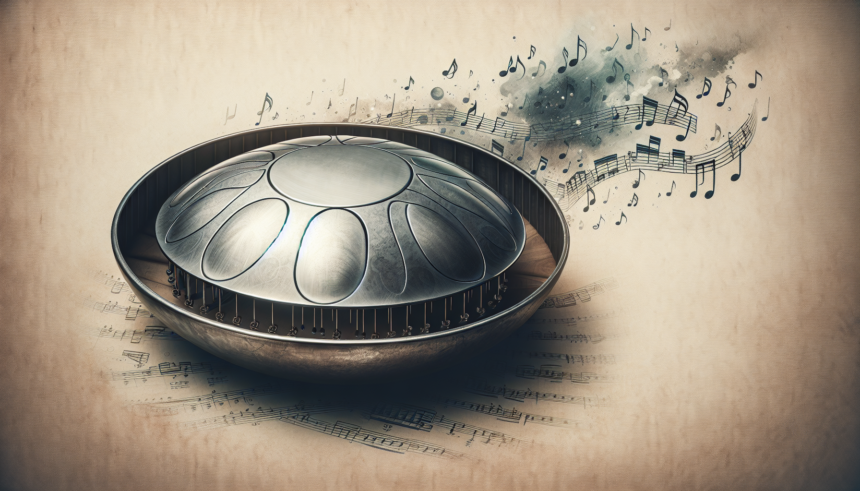The handpan is a captivating musical instrument that marries percussive and melodic elements in a sleek, modern design. From the moment its otherworldly tones were introduced to the world, musicians everywhere have been eager to expand their repertoires and explore the limitless possibilities offered by this unique instrument. One of the advanced techniques that can be incorporated into your handpan playing is the use of ghost notes. These subtle, nuanced notes add depth and complexity to your music, making your performances more dynamic and engaging.
What Are Ghost Notes?
Ghost notes are essentially quieter notes that are played softly and subtly. In the context of handpan playing, they are used to add texture and rhythmic interest to a piece. Unlike regular notes, which are meant to be prominent and clearly heard, ghost notes are subtle and often felt more than heard. They can be played on any part of the handpan but are typically executed on the side of the instrument, near the tone fields. The challenge lies in executing them with precision and control, ensuring they complement rather than overpower the primary melody.
The Importance of Ghost Notes
Incorporating ghost notes into your handpan repertoire offers several advantages:
- Textural Variation: Ghost notes introduce an additional layer of complexity to your music, providing a richer, more textured soundscape.
- Rhythmic Enhancement: They can add subtle rhythmic accents that make your music more engaging and interesting to listen to.
- Dynamic Range: The use of ghost notes expands the dynamic range of your playing, giving you more control over the loudness and softness of your performance.
How to Play Ghost Notes
Mastering ghost notes on the handpan requires practice and attention to detail. Here are some steps to help you get started:
1. Start Slow
Begin by practicing ghost notes slowly to develop the muscle memory needed for precision. Focus on tapping the handpan lightly, ensuring that the notes are barely audible. Use only the tips of your fingers, and try to avoid using too much force.
2. Practice Rhythmic Patterns
Incorporate ghost notes into various rhythmic patterns. This will help you become more comfortable with their placement in different musical contexts. Start with simple patterns and gradually introduce more complexity as you become more proficient.
3. Experiment with Finger Placement
Experiment with different finger placements and techniques to find what works best for you. Some players prefer using the index finger, while others might favor the middle or ring finger. The exact placement and technique can vary depending on your playing style and the specific handpan you are using.
4. Listen and Adjust
Record yourself playing with ghost notes and listen back to identify areas where you can improve. Pay attention to the balance between ghost notes and regular notes, ensuring that the ghost notes are subtle yet impactful. Make adjustments as needed to refine your technique.
Integrating Ghost Notes into Your Music
Once you’ve developed the necessary skills to play ghost notes, the next step is to integrate them into your music. Here are some ideas to help you get started:
1. Create Contrast
Use ghost notes to create contrast in your music. For example, you can play a series of loud, prominent notes followed by a few ghost notes to create a sense of tension and release. This contrast can add emotional depth to your performance.
2. Highlight Rhythmic Accents
Ghost notes can be used to highlight specific rhythmic accents in your music. For example, you might use ghost notes to emphasize the offbeats in a rhythmic pattern, adding a subtle layer of complexity. This technique is particularly effective in percussive handpan playing.
3. Enhance Melodic Phrases
Incorporate ghost notes into melodic phrases to create a sense of flow and continuity. For example, you can use ghost notes as transitional elements between the main notes of a melody, creating a smoother and more cohesive musical line.
4. Add Subtle Harmonics
In addition to their rhythmic role, ghost notes can also add subtle harmonic elements to your music. When played near the tone fields of the handpan, ghost notes can produce delicate overtones that enhance the overall harmonic richness of your performance.
Troubleshooting Common Challenges
As with any advanced technique, incorporating ghost notes into your handpan playing can come with its own set of challenges. Here are a few common issues and some tips for troubleshooting them:
1. Inconsistent Volume
If your ghost notes are inconsistent in volume, practice controlling the force you use when striking the handpan. Focus on using a light touch and aim for a consistent sound across all ghost notes. Recording your practice sessions and listening back can help you identify areas for improvement.
2. Difficulty in Placement
If you’re having trouble placing ghost notes accurately, slow down your practice and break down the rhythm into smaller segments. Focus on the placement of each ghost note within the context of the overall pattern. Gradually increase the tempo as you become more comfortable.
3. Balancing Ghost Notes and Regular Notes
Maintaining the right balance between ghost notes and regular notes can be challenging. Pay attention to the dynamics of your playing and make sure that the ghost notes remain subtle and don’t overpower the main melody. Regularly check your volume levels and make adjustments as needed.
Conclusion
Incorporating ghost notes into your handpan repertoire can elevate your playing to new heights, adding depth, complexity, and nuance to your music. By understanding what ghost notes are, practicing the necessary techniques, and integrating them thoughtfully into your compositions, you can create performances that are more engaging and expressive. Remember that mastery of ghost notes, like any advanced technique, requires patience, practice, and attention to detail. Keep refining your skills, and you’ll find that ghost notes become a natural and integral part of your musical vocabulary.
Frequently Asked Questions (FAQs)
1. What are ghost notes in handpan playing?
Ghost notes are subtle, quieter notes that add texture and rhythmic interest to handpan music. They are typically played with a light touch and are often felt more than heard.
2. Why should I incorporate ghost notes into my handpan repertoire?
Incorporating ghost notes into your repertoire adds textural variation, enhances rhythmic complexity, and expands the dynamic range of your performance. They make your music more engaging and expressive.
3. How do I practice ghost notes on the handpan?
Start by practicing ghost notes slowly, using a light touch with the tips of your fingers. Incorporate them into various rhythmic patterns and experiment with different finger placements. Record and listen to your practice sessions to identify areas for improvement.
4. What are some common challenges when playing ghost notes?
Common challenges include inconsistent volume, difficulty in placement, and balancing ghost notes with regular notes. These challenges can be addressed through focused practice and attention to dynamics.
5. Can ghost notes be used for melodic as well as rhythmic purposes?
Yes, ghost notes can enhance both melodic and rhythmic aspects of handpan music. They can add fluidity and continuity to melodic phrases and highlight specific rhythmic accents in percussive patterns.





